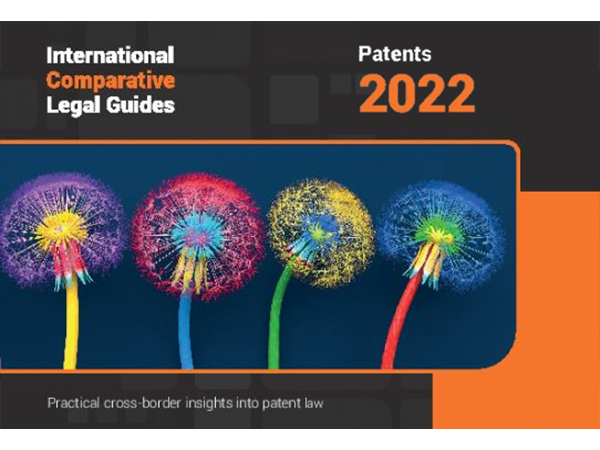
Intellectual Property
Viewpoints
Filter by:
Picture Claims as an Effective Patent Strategy: Top 10 Reasons to Precisely Tailor Your Patent Claim
September 6, 2023 | Blog | By James Whittle, PhD, Terri Shieh-Newton, Dean Farmer, PhD
A “picture” claim refers to a patent claim precisely tailored to track a particular product’s important advantages and features. When drafting a patent application, one should describe various embodiments of the invention and include both picture claims, tailored to those embodiments, and broader claims, to encompass groups of embodiments.
Federal Circuit Clarifies That Secondary Considerations Must Be Considered Both Individually And As A Whole In An Obviousness Analysis
August 31, 2023 | Blog | By Michael Newman, Peter Cuomo, Paul Weinand
On August 24, 2023, the U.S. Court of Appeals for the Federal Circuit, in Volvo Penta of the Ams. LLC v. Brunswick Corp., Case No. 22-1765, vacated a Final Written Decision of the Patent Trial and Appeal Board (PTAB) holding all claims of U.S. Patent 9,630,692 (the “’962 patent”) unpatentable as obvious.
Distinguishing Patent Protection from Patient Safety – A Role for the FDA
August 21, 2023 | Blog | By Peter Hecker, PhD, Lee Johnson, PhD
At its heart, a patent grants the right to stop another person from doing whatever falls within the scope of the patent’s claims. A patent is not a right to practice what is included in the patent, or a government stamp of approval on everything within the scope of its claims.
Can Enablement and Written Description Bars be Lower for Method-Of-Treatment Patent Claims?
August 21, 2023 | Blog | By Lei Xu, PhD, Dean Farmer, PhD, Christina Sperry
Patent offices may reject a patent application with claims reciting using a composition to treat a disease, based on the requirement that the claimed treatment is not fully supported by the application.
An Overview of Shotgun Pleadings in the Federal Courts
August 7, 2023 | Blog | By Joe Rutkowski, Peter Cuomo
Advice that may have served House of Pain in their 1992 hit song, “Jump Around,” to “bring a shotgun” to battle likely does not translate well to plaintiffs in federal litigation contemplating bringing a “shotgun” pleading to court. In this article we explore types of shotgun pleadings identified by courts and outline potential responses to a shotgun pleading.
Why Pharma Companies Should File Patents Later In The R&D Process
July 25, 2023 | Blog | By Alex Trimble, PhD
Filing a pharmaceutical patent application after the start of Phase II clinical trials can maximize the patent’s value and exclusivity period. In an article also published in IAM magazine, Mintz Member Alex Trimble talks about delayed filing options and how to avoid invalidation of the patent based on its “public use” during the clinical trial or published information about the trial.
Split Decisions: Can a Complaint Serve as Knowledge of Indirect Infringement?
July 21, 2023 | Blog | By Daniel Weinger, Simone Yhap
A frequent issue seen within patent litigation is whether serving a complaint satisfies the knowledge requirement for post-complaint indirect infringement. This issue affects the amount of, if any, damages a patent owner can obtain.
Disqualifying an Inventor’s Prior Publication as Prior Art – Invoking §102(b)(1)(A)
July 6, 2023 | Blog | By James Whittle, PhD, Dean Farmer, PhD
An invention is not patentable if it was described in, or obvious in view of, an earlier printed publication. See 35 U.S.C. 102(a)(1). This blog post addresses how to overcome an anticipation or obviousness rejection where an inventor is the author or otherwise the source of subject matter in the publication cited as prior art
Supreme Court: Parody Not a Shield from Trademark Infringement
June 9, 2023 | Blog | By Michael Graif
In Jack Daniels Properties, Inc. v. VIP Products LLC, (slip. op. No. 22-148, June 8, 2023), the United States Supreme Court reversed the Ninth Circuit, ruling that a “Bad Spaniels” dog toy designed to look like a Jack Daniels liquor bottle did not avoid trademark infringement merely because it was a parody.
Intellectual Property for the Metaverse
May 24, 2023 | Blog | By Frank Gerratana, Amritaa Ganguly
As metaverse-related technology and branding initiatives continue to grow, innovators in the space may need to pursue IP protection. Mintz Member Frank Gerratana and Associate Amritaa Ganguly discuss the use of patents, trademarks, and copyrights to protect innovations and creative activity associated with this new virtual world.
Nothing for free – the real costs of ChatGPT
May 11, 2023 | Blog | By Michael Renaud, Marguerite McConihe, Nana Liu
Making Bacon Still Requires a Significant Contribution for Joint Inventorship
May 10, 2023 | Blog | By Peter Cuomo, Hannah Edge
I Spy a Trade Secret: Conducting Proper Trade Secret Asset Management Review to Avoid Sufficiency Failure in Litigation
April 5, 2023 | Blog | By Nicholas Armington , Michael Renaud, Jonathan Engler
Successful defense of trade secrets in litigation begins with evaluating valuable confidential information and steps taken to safeguard it before any disputes arise. Trade secret asset management allows companies to effectively frame misappropriation or theft claims and advance arguments at every stage of a trade secrets dispute.
Benefits and Legal Risks of Embracing Generative AI Applications
April 5, 2023 | Blog | By Jeremy Glaser, Lorena Niebla
Generative artificial intelligence creates content and work efficiencies but also comes with legal pitfalls. Mintz Venture Capital & Emerging Companies Practice Co-chair Jeremy Glaser and Associate Lorena Niebla look at the technology's potential uses as well as risks related to data privacy, intellectual property, and more.
Federal Circuit Affirms Delisting of REMS System Patent from FDA Orange Book
March 6, 2023 | Blog | By Peter Cuomo, Adam Samansky, Peter McFadden
On February 24, 2023, the U.S. Court of Appeals for the Federal Circuit, in Jazz Pharmaceuticals, Inc., v. Avadel CNS Pharmaceuticals, LLC, Case No. 23-1186, affirmed a decision from the District Court of Delaware directing Jazz Pharmaceuticals, Inc. (“Jazz”) to delist U.S. Patent No. 8,731,963 (the “’963 patent”) from the FDA’s Approved Drug Products with Therapeutic Equivalence Evaluations publication (the “Orange Book”). The district court held, and the Federal Circuit affirmed, that the ’963 patent, which covers Risk Evaluation and Mitigation Strategies (“REMS”) for the narcolepsy drug Xyrem®, failed to claim a drug or method of use, and was thus improperly listed.
Avoiding Pitfalls: IP “Dos and Don’ts” for High-Tech Start Ups
February 27, 2023 | Blog | By Daniel Weinger, Frank Gerratana, Greg Penoyer
Starting a high-tech company is a difficult, exhausting, and thrilling endeavor – one in which founders will face seemingly endless challenges, deadlines, and make or break decisions. From a venture’s inception, founders face numerous decisions that if not thoughtfully considered can result in significant legal and financial risk.
Lensa: Are AI Art Generators Copyright Infringers?
February 15, 2023 | Blog | By Frank Gerratana, Michael Graif , Sebastian Navarro
Artificial Intelligence (AI) is now at our fingertips. No longer a concept hidden behind the walls of Big Tech and academia, AI programs are now available and accessible to everyone. Generative AI tools like ChatGPT have made headlines for its human-like conversation and writing, and Lensa has done the same for its ability to create original works of art.
Federal Circuit Resolves District Court Split, Holds Foreign Defendant Cannot Defeat Rule 4(k)(2) Personal Jurisdiction by Unilateral Post-suit Consent to Jurisdiction in Alternative Forum
January 23, 2023 | Blog | By Joe Rutkowski, Adam Samansky, Peter Cuomo
On January 9, 2023, the U.S. Court of Appeals for the Federal Circuit in In re Stingray IP Solutions, LLC, No. 23-102 granted a writ of mandamus, vacating a decision of the Eastern District Court of Texas which had transferred a patent infringement suit filed against foreign defendants to the Central District of California based on defendants’ post-suit consent to jurisdiction there.
Year in Review: The Most Popular IP Posts of 2022
January 5, 2023 | Blog | By Christina Sperry
Innovators developing IP strategies for 2023 are reflecting on last year’s key IP issues, including entity size designations for US patent applications, erasures of patent damage awards due to flawed expert opinions, and developments involving the ITC, artificial intelligence and machine learning, and inter partes reviews.
Explore Other Viewpoints:
- Data Centers & Digital Infrastructure
- AI: The Washington Report
- Antitrust and Federal Regulation
- Appellate
- Arbitration, Mediation & Alternate Dispute Resolution
- Artificial Intelligence
- Awards
- Bankruptcy & Restructuring
- California Land Use
- Cannabis
- Class Action
- Complex Commercial Litigation
- Construction
- Consumer Product Safety
- Corporate Governance (ESG)
- Cross-Border Asset Recovery
- DEI Legal Developments
- Debt Financing
- Direct Investing (M&A)
- Diversity
- EB-5 Financing
- Education & Nonprofits
- Employment
- EnforceMintz
- Environmental (ESG)
- Environmental Enforcement Defense
- Environmental Law
- Environmental, Social, and Corporate Governance (ESG)
- FDA Regulatory
- False Claims Act
- Federal Circuit Appeals
- Financial Institution Litigation
- Government Law
- Growth Equity
- Health Care
- Health Care Compliance, Fraud and Abuse, & Regulatory Counseling
- Health Care Enforcement & Investigations
- Health Care Transactions
- Health Information Privacy & Security
- IP Due Diligence
- IPRs & Other Post Grant Proceedings
- Immigration
- Impacts of a New US Administration
- Insolvency & Creditor Rights Litigation
- Institutional Investor Class Action Recovery
- Insurance & Financial Services
- Insurance Consulting & Risk Management
- Insurance and Reinsurance Problem-Solving & Dispute Resolution
- Intellectual Property
- Investment Funds
- Israel
- Licensing & Technology Transactions
- Life Sciences
- Litigation & Investigations
- M&A Litigation
- ML Strategies
- Managed Care
- Medicare, Medicaid and Commercial Coverage & Reimbursement
- Mergers & Acquisitions
- Patent Litigation
- Patent Prosecution & Strategic Counseling
- Pharmacy Benefits and PBM Contracting
- Portfolio Companies
- Privacy & Cybersecurity
- Private Client
- Private Equity
- Pro Bono
- Probate & Fiduciary Litigation
- Products Liability & Complex Tort
- Projects & Infrastructure
- Public Finance
- Real Estate Litigation
- Real Estate Transactions
- Real Estate, Construction & Infrastructure
- Retail & Consumer Products
- Securities & Capital Markets
- Securities Litigation
- Social (ESG)
- Special Purpose Acquisition Company (SPACs)
- Sports & Entertainment
- State Attorneys General
- Strategic IP Monetization & Licensing
- Sustainable Energy & Infrastructure
- Tax
- Technology
- Technology, Communications & Media
- Technology, Communications & Media Litigation
- Trade Secrets
- Trademark & Copyright
- Trademark Litigation
- Unified Patent Court (UPC)
- Value-Based Care
- Venture Capital & Emerging Companies
- White Collar Defense & Government Investigations
- Women's Health and Technology








